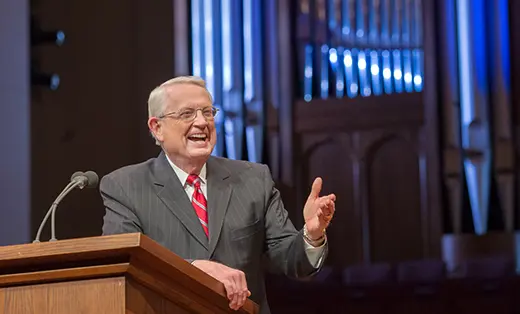The Full Gospel . . . And Nothing More
By Michael J. Svigel
In Bible college I sat under Dr. Charles Ryrie for a course in soteriology—the doctrine of salvation. He opened the first lecture with this instruction: “Take out a piece of paper. You have less than one minute to share the gospel with a stranger, or he’ll be lost for eternity. Write down what that person needs to believe to be saved. Start now!”
The next sixty seconds seemed to pass in a flash. Then the situation became worse when he told us to grade our neighbor’s gospel presentation. Rather than assigning a grade of “pass” or “fail,” we were tasked to grade it according to the likely outcome . . . “heaven” or “hell.”
Now that’s pressure.
If you had less than a minute to share the message of salvation with somebody, would you be able to simply summarize the full gospel and nothing more? Could you trim the fat without cutting the meat? Take out a piece of paper and challenge yourself right now, then read on.
In 1 Corinthians 15:1–5, Paul reiterated to the Corinthian Christians “the gospel,” which he preached to them, which they received, and in which they stood (15:1). By this message—nothing more, nothing less—believers are saved (15:2): “that Christ died for our sins according to the Scriptures, and that He was buried, and that He was raised on the third day according to the Scriptures, and that He appeared to Cephas, then to the twelve” (1 Corinthians 15:3–5).
Paul’s presentation and argument were tight: Christ died for our sins—in our place. His burial demonstrated the reality of His death, which fulfilled Old Testament prophecies (Isaiah 53:49). Christ rose victoriously from the dead—a fact proven by the numerous eyewitnesses and also predicted in Scripture (Isaiah 53:10–12).
Christ died for our sins and rose from the dead. The gospel is that simple. Though we might need to explain who Christ is (John 1:1; 20:31), show that a person actually needs a Savior (Romans 3:23), or ask a person to respond by faith alone in Christ alone (Ephesians 2:8–9), the gospel message itself is simple.
Now return to your piece of paper and quickly write it down: the full gospel and nothing more.
Adapted from Michael J. Svigel, “The Full Gospel . . . and Nothing More,” Insights (August 2006): 2. Copyright © 2006 by Insight for Living. All rights reserved worldwide.
About the author
 Michael J. Svigel
Michael J. Svigel
Michael J. Svigel received his master of theology in New Testament and doctor of philosophy in Theological Studies from Dallas Theological Seminary (DTS). He currently serves as associate professor of Theological Studies at DTS, teaching Theology and Church History. Prior to accepting his position at the seminary in 2007, he worked as a writer in the Creative Ministries Department at Insight for Living Ministries. Mike and his wife, Stephanie, are parents of three children.
